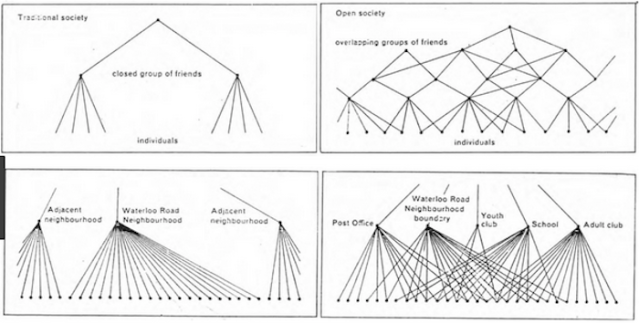
From A City Is Not a Tree,” another pathbreaking work by Christopher Alexander.
Some very interesting commenters have responded to my post “Chris Alexander’s cosmos.” The title of Alexander’s most celebrated book, A Pattern Language, spoke so directly in a mere three words to my nascent views on architecture long, long ago that I lodged him in my pantheon of heroes. But all of my heroes seem to have clay feet, or at least a couple of clay toes.
For me, Alexander’s Achilles heel was not his written but his built work, which to me seemed generally less exalted than his philosophy might imply. I see no need for a new way of building, or even an old way if it minimizes ornament – merely a return to all that was abandoned in the middle of the 20th century, a return and a recommencement of its centuries and millennia of evolution. Although I did not mention that in my recent post, I have mentioned it in past posts, as some commenters seem to recall.
So for that and other excellent points they bring out, I would suggest revisiting the post to read the comments. I will extract here only one, from Steven Semes, of Notre Dame’s architecture school. And I would point to his last sentence, which is so keen. Here is his comment:
What Nikos is describing in perhaps more specialized language is precisely what you and most people intuitively understand about architecture and the built world. First, no individual building can be designed or judged in isolation, but must connect with whatever is around it or preceded it. Buildings must compose cities and landscapes, not be individual works of sculpture. Secondly, ornament is functional because it draws our attention to other connections, not physical ones but cultural and spiritual ones. Ornament connects us with the things we use, draws us in, and (not to be undervalued) gives us pleasure. I think what Nikos and Alexander are doing is making a more intellectual case for our participation in what Alexander calls “Life” – and that term should be a give-away that it is not an elitist concept but something fundamental in the way the world and our own brains work. In this case, the theory is something we have to invent when we’ve forgotten how to do automatically what the theory describes. [Emphasis added.]



Just love the image of the town across the top of the website you linked us to, Leveveg! What you say about the Eishin Campus fills me with hope.
LikeLiked by 1 person
Thanks! It can be downloaded on the bottom of this page: http://www.villageforum.com
Why not use it on your own blog? Sure the Village Forum would appreciate that! The balusters don’t say much.
LikeLike
Well, I appreciate that, Leveveg, but I really do love the balusters. Village Forum uses the village as its portal image so I ought not to. They got there first, and in fact my blog is not an urbanist blog primarily but a style wars blog. It supports good urbanism but does not imagine itself as among the leading urbanist sites in what is a much bigger and certainly more comprehensive movement than the movement to revive classicism. Some urbanists rather think we could do without the style wars. Still, kind of you to suggest!
LikeLike
All in all the Eishin Campus is a success, considered the powers Alexander had to fight, partly leaving him ill in Berkeley with no control on the crazy developers. There might lack some ornament and details, but as a unique learning environment combining the charm of a village with the romantic park, Alexander achieved his grand vision!
– Alexander Centering: extract the design from the land itself: https://permaliv.blogspot.no/2012/05/alexander-centering.html
LikeLike